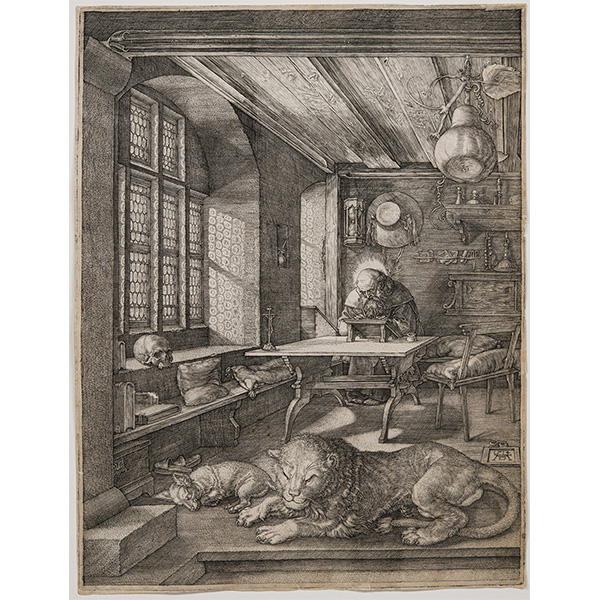
動画による作品解説
アルブレヒト・デューラー
《書斎の聖ヒエロニムス》
1514年 エングレーヴィング・紙 24.9×19.2 cm
Albrecht Dürer
Saint Jerome in His Study
Heiliger Hieronymus im Gehäuse
1514, engraving on paper, 24.9 × 19.2 cm
この作品はアルブレヒト・デューラーが制作した銅版画のなかでも最高傑作と呼ばれる三大銅版画のひとつです。僧房のような空間で、書き物をしている聖ヒエロニムスが描かれています。彼は聖書をラテン語へと翻訳したウルガタ訳聖書の翻訳者として、しばしば書斎で書き物をする姿で描かれました。
聖人の手前には、ライオンが寝そべっています。中世の聖人伝説を集めた『黄金伝説』によると、聖ヒエロニムスは、ライオンの足に刺さった棘を抜いて助けたことが記されています。このエピソードから、しばしばライオンはこの聖人の忠実な友として美術作品に登場します。
本作でデューラーの銅版画技術は最高度に達しました。まず遠近法による空間は、この小さな画面の中にかなり奥深い空間を生み出すことに成功しており、線を並べたハッチングに加えて、線を交差させるクロスハッチングによって、幅広い明暗と対象の質感を生み出しました。窓から部屋へと差し込む光は、輪郭線ではなく、途切れ途切れの線を並べて表現され、ガラスを通した柔らかな効果を巧みに表しています。
This work is one of Albrecht Dürer's three greatest engravings, often regarded as the pinnacle of his copperplate. It depicts Saint Jerome engaged in writing within a cloister-like study. Saint Jerome, known for translating the Bible into the Latin Vulgate, is frequently portrayed in art as writing in his study.
In the foreground lies a lion, an attribute commonly associated with the saint. According to The Golden Legend, a collection of medieval hagiographies, Saint Jerome once aided a lion by removing a thorn from its paw. This act of compassion led to the lion being depicted in artworks as the saint's loyal companion.
In this engraving, Dürer achieved the zenith of his technical mastery. The use of perspective creates a remarkably deep spatial effect within the small frame. Through parallel hatching and cross-hatching, Dürer skillfully rendered a wide range of light, shadow, and texture. The light streaming through the window into the room is ingeniously depicted not with solid lines but with broken, parallel strokes, capturing the soft, diffused quality of light filtered through glass.
